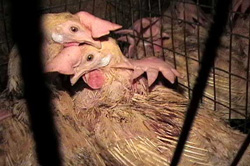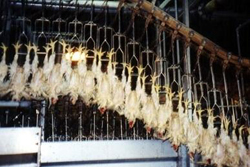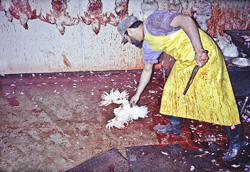Fundraiser for Animals Serves Barbequed Chickens
By Frank Parlato
 |
| NCSPCA fundraiser serves up delivious BBQ chickens to raise money for dogs and cats. |
 |
| They live their lives in cages. |
 |
| Live chickens head to meet their maker. |
 |
| This one fell off the conveyor belt and is given personal attention. |
Of course I thought it strange to think of raising money to save dogs and cats by serving up BBQ chicken.
The smoke was the same in appearance, I thought, as that which rises from the crematory at the back of the SPCA on the Tuesday burnings of flesh and bones of euthanized dogs and cats.
The smell of the smoke from Chiavetta’s delicately smoked chickens, used to raise money at the SPCA fundraiser, was positively delectable.
If we could judge ethics by smell alone, burning and eating chickens is far different than burning cats and dogs.
But before we pass on the dubious advantages of trying to have a vegetarian fundraiser when trying to stop cruelty to animals, let us take a moment to consider what happened to the chickens before they got on our plate to save the dogs and cats.
Every year, more than 9 billion chickens are raised and killed for meat in the United States. They start their lives in incubator drawers at chicken hatcheries and are delivered to the broiler houses. Shortly after being born, the ends of their beaks are cut off, which is known as "debeaking." Most broiler chickens are genetically altered to grow faster and produce more meat.
These genetic alterations cause the animal’s legs to have trouble supporting their heavier bodies. Their underdeveloped heart and lungs frequently result in congestive heart failure. During their comparatively short lives, they live in large sheds called "grower houses,” which afford them nearly one- half square foot of space per chicken. Artificial lighting is used to encourage the birds to eat as often as possible.
When the appropriate time comes, usually when "broiler" chickens are six weeks old, they are transported in trucks to the slaughterhouse in handsome crates.
Once the chickens arrive, they are pulled from their crates or dumped by cranes onto efficient conveyer belts and hung by their feet from shackles on a moving rail, which permit thousands of chickens to be dispatched per hour.
Poultry is excluded from the Humane Slaughter Act, so stunning the chickens is not mandatory. Chickens, however, are often stunned by running them through electrified water. Sometimes to conserve electricity, slaughterhouses use lower currents than required to actually stun the chickens which mean they can still feel pain when their throats are slashed. In any event, after their throats are slashed, they are submerged in a scalding tank. It is not uncommon for chickens to still be alive when they reach the scalding tank. The industry has a rather cute name for them: "redskins.”
The chickens quickly sold out at the SPCA fundraiser, and many visitors were disappointed and had to be satisfied with black beans, tortillas, popcorn, coleslaw and other former plants all of which are treated quite inhumanely by farmers tending their fields.